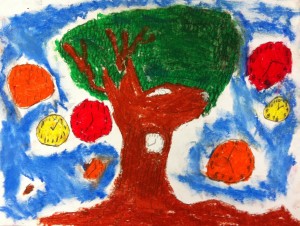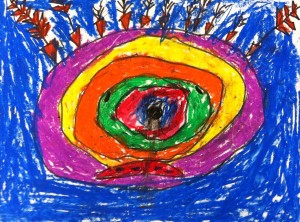Sub‐Questions:
- What is surrealism?
- What is the difference between hidden and visible?
- How can a drawing surprise you?
.
Learning Objectives:
- Students will learn the process of creating a drawing within a drawing.
- Students will understand the concept of discovering new shapes/information in drawing by looking at drawings and paintings by Salvador Dalí and Dorothea Tanning paintings.
- Students will be introduced to Surrealism
- Students will learn the technique of line drawing with pencil and practice camouflaging objects within other objects.
.
Resources and Materials:
- Drawings and paintings by Salvador Dalí and Dorothea Tanning.
- Images of clouds, mountains and cities with hidden visual information.
- Drawing paper (cut into 6×4 in. pieces)
- Pencils
- Black markers
- Colored pencils
Procedure:
- Students will gather in front of the smart board for a brief presentation.
- Students will look at an interactive slideshow. The presentation will begin with a picture of clouds, and students will be asked to identify any shapes they can find. During this portion of the slide show, students will begin to discover that images can be looked at in more than one way.
○ Students come to the front of the class and use the smart board marker to outline the hidden shapes they see.
○ Up to five volunteers can participate per image. Every student is encouraged to participate, and it is established that if they have gone once, somebody who hasn’t has priority if they raise their hand. - After looking at a few other images from nature, they will look at paintings and drawings by Salvador Dalí and Dorothea Tanning.
○ The procedure in this portion of the slide show is much like the one in place for the previous images. Students can volunteer to come to the front of the room and outline or point out secret images within the drawing.
○ It is emphasized that the artists planted these images as they were making the work, considering their meaning, as well as the magic of discovery throughout their process. Students will then see a brief, edited video by Dalí and Walt Disney titled Destino.
○ During the video, students may call out images that they begin to see take form.
After the presntation, students engage in a discussion about why a drawing or painting with a secret is different from a regular drawing
→ Bring up the dreamy quality of discovery in relation to surrealism.
○ Key words are emphasized: surrealism, dream, discovery.
○ Questions about process and meaning prompt the direction of the conversartion.
Once the visuals have been synthesized, students transition to the demo table for a quick example of drawing, outlining, and coloring to camouflage.
○ Students offer possibilities for an object that can be hidden within another object. For example, a snake can hide within a river.
- Students get to work.
- If they don’t finish, perhaps they can continue their work next session. If they do, we can conclude by viewing their work at the end of the class.
Students will be evaluated based on participation during the slide show (expectation of respectful behavior).
○ The expectation involves sitting respectfully (giving other students space), raising thumbs to participate (not calling out answers), and volunteering at least once.
Students should follow the procedure for creating their “drawing with a secret” successfully.
○ There should be one image hidden within another image, and students should be able to describe their choices. For example, one student created a fly with a radio for a head, because they both made a similar buzzing sound. Another student hid a deer inside of the tree, because the branches and the deer antlers have similar contortions.
As a final evaluation, students should demonstrate creativity and craftsmanship, and be able to describe their decision-making process.
.
Assessment of Teaching:
Was the big idea/question relevant and compelling to the students? If not, how would I modify or change it?
→ It was, they showed enthusiasm and remarkable creativity. The next time I try this lesson, I might change the time frame to permit more elaborate work, and perhaps try different media, such as white pastels and watercolor. The combination of these materials lends itself to planting discoveries in an image.
Did the sequence of learning activities and assignments flow smoothly and integrate the learning objectives? Do I have further ideas about how these learning objectives can be achieved?
→ It was good to transition from clouds and simple imagery to more complex paintings. Students were able to fall into a rhythm of identifying secret images, and understood that during art making, the process happens backwards. Artists consider what they want to hide based on concept and shape, and then surround the image to disguise it.
.
Art Standards:
Standard 2: Knowing and Using Arts Materials and Resources
Students will be knowledgeable about and make use of the materials and resources available for participation in the arts in various roles.
Standard 3: Responding to and Analyzing Works of Art
Students will respond critically to a variety of works in the arts, connecting the individual work to other works and to other aspects of human endeavor and thought.









